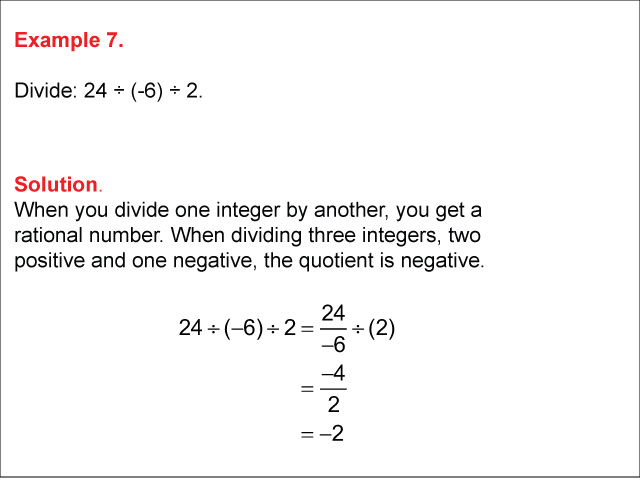
Display Title
Math Example--Numerical Expressions--Dividing Integers: Example 7
Display Title
Math Example--Numerical Expressions--Dividing Integers: Example 7

Topic
Numerical Expressions
Description
This example illustrates the division of three integers: 24 ÷ (-6) ÷ 2. The solution demonstrates that dividing three integers, two positive and one negative, results in a negative quotient. The calculation is presented step-by-step: 24 ÷ (-6) ÷ 2 = -4 / 2 = -2.
Understanding the division of multiple integers with mixed signs is a crucial aspect of working with numerical expressions. This collection of examples helps teach the concept by showcasing various scenarios, allowing students to observe patterns and develop a deeper understanding of how the order of operations and the signs of the integers affect the final quotient.
Exposure to multiple worked-out examples is essential for students to fully grasp the concept of dividing multiple integers with different signs. Each example reinforces the rules of order of operations and sign rules, helping students recognize the patterns in results and building their confidence to solve more complex problems independently.
Teacher Script: "Let's examine this example where we're dividing three integers, with a negative number in the middle. Notice how we perform the divisions from left to right and how the negative number affects our intermediate and final results. Can you explain why we get a negative answer? Let's work through the problem step-by-step and discuss the reasoning behind our result. How does this example compare to the previous one?"
For a complete collection of math examples related to Numerical Expressions click on this link: Math Examples: Dividing Integers Collection.
| Common Core Standards | CCSS.MATH.CONTENT.7.NS.A.2 |
|---|---|
| Grade Range | 6 - 8 |
| Curriculum Nodes |
Algebra • The Language of Math • Numerical Expressions |
| Copyright Year | 2014 |
| Keywords | integers, integer, positive numbers, negative numbers, positive, negative, zero, dividing integers |